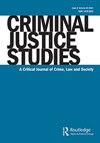严重犯罪判决后就业中的种族差异
IF 1.1
Q3 OPERATIONS RESEARCH & MANAGEMENT SCIENCE
引用次数: 0
摘要
摘要先前的研究强调了就业和劳动力参与方面持续存在的种族/民族差异。也就是说,这项研究尚未扩展到涉及司法的年轻人。这是有问题的,因为这一人群可能已经面临就业障碍,而某些种族/族裔少数群体可能会面临额外的障碍。这项研究试图通过调查参与司法的年轻人在就业方面是否存在种族/民族差异,以及自裁决以来这些差异是否随时间而变化,来解决文献中的这一差距。对“渴望之路”研究的前七波进行了分析。使用混合效应模型来研究参与司法的年轻人在过去一年的就业几率中是否存在种族/民族差异,以及这些差异是否随着时间的推移而稳定或变化。结果表明,与白人和拉丁裔司法参与青年相比,黑人司法参与青年去年就业的几率较低。研究还发现,这些差异在一段时间内是稳定的。这些结果表明,参与黑人司法的年轻人应该是改善就业前景的优先人群。辅导和技能发展计划在这方面可能会有所帮助。本文章由计算机程序翻译,如有差异,请以英文原文为准。
Racial disparities in employment following adjudication for a serious offense
ABSTRACT Prior research has highlighted persistent racial/ethnic disparities in employment and workforce engagement. That said, this research has yet to be extended to justice-involved youth. This is problematic, given that this is a population that may already face barriers to employment and certain racial/ethnic minority groups may then face additional barriers. This study sought to address this gap in the literature by examining whether or not racial/ethnic disparities in employment exist among justice-involved youth and whether these disparities vary across time since adjudication. The first seven waves of the Pathways to Desistance study were analyzed. Mixed effects modeling was used to examine whether or not racial/ethnic disparities in odds of past-year employment existed among justice-involved youth and whether these disparities were stable or variant across time. Results indicated that Black justice-involved youth reported lower odds of past-year employment compared to White and Latinx justice-involved youth. These disparities were also found to be stable across time. These results indicate that Black justice-involved youth should be a priority population for targeting with programming to improve employment prospects. Mentoring and skills development programs may be helpful in this regard.
求助全文
通过发布文献求助,成功后即可免费获取论文全文。
去求助
来源期刊

CRIMINAL JUSTICE STUDIES
OPERATIONS RESEARCH & MANAGEMENT SCIENCE-
CiteScore
2.80
自引率
5.60%
发文量
17
期刊介绍:
Criminal Justice Studies, a quarterly refereed journal, publishes articles that deal with substantive criminal justice and criminological issues. The journal welcomes all articles that are relevant to the issue of criminal justice, as well as those that may be outside the field but have relevancy to the topic of criminal justice. Articles that cover public administration, issues of public policy, as well as public affairs issues are welcome. The journal also publishes relevant literature reviews, research notes and summary reports of innovative research projects in criminal justice. Qualitative and quantifiable articles are sought mainly from academics and researchers in the field, though articles from professionals will also be considered.
 求助内容:
求助内容: 应助结果提醒方式:
应助结果提醒方式:


